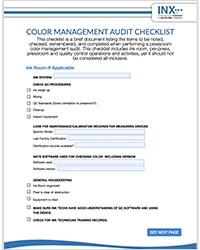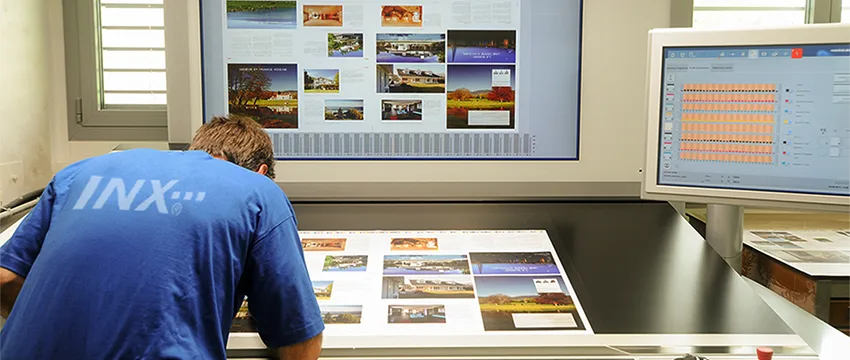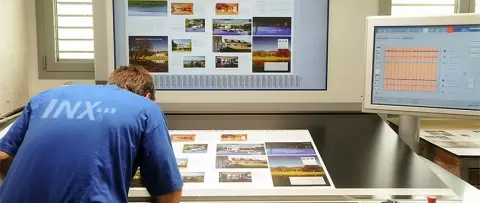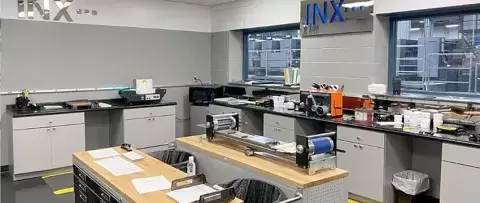The Why and How of Color Management Audits
For any PSP (Print Service Provider) operating today, the quest to achieve exemplary, repeatable color should involve neither mystery nor miracle. As printing has become increasingly technical–where even analog technologies are assisted by software–it has become much less of a craft and much more of a science. Color itself is a science that includes (if we choose to use them) color standards, tools, methods, and audits.
According to Harvey Buck, Technical Service Representative with INX, “Strong attention to color is most important because visible color variation is the main reason print buyers seek another PSP." "Just because they’re not complaining, doesn’t mean they’re happy. Color quality also affects overall company profitability.” Robert Ciezczak, Color Management Specialist at INX, says, “It is essential that PSPs deliver the customer’s product as specified, and produced with consistency.”
Conducting a color management audit should be an essential and ongoing step in ensuring quality and maintaining customer satisfaction. But how should the audit be conducted, and by whom? What steps can be taken to ensure it brings meaningful change?
Preparing for a Color Management Audit
While the steps needed to approach a color management audit will vary from printer to printer, the baseline focus of the effort should be on meeting customer demand and doing so consistently. “The goal of the audit,” he says, “is to prove internally that software, input devices, and output devices are all operating on a common color-focused level. This approach should also include consistency from output device to output device, which is referred to as, conversion."
A carefully conducted audit provides proof that color can be reproduced within set expectations and serves to take the guesswork out of the process. Ciezczak says, "This means following the numbers instead of the hunches or opinions of production employees and others.
Companies undertaking their first steps into color management auditing may have a common question: what do I need in place to get started? Preparing for an audit is aided by listing those elements within a PSP that will receive the most attention:
- Ensure devices (monitors, proofers, printers, presses) are stable and working properly
- Be prepared to show a regular schedule of calibration and preventive maintenance
- Be able to prove each department has a clear awareness of customer expectations and demands
- Exhibit continuous improvement through training and staying up to date with the latest technology
- Show a workflow that proves and displays color consistency and predictability throughout
- Determine whether a finished print matches its proof

Steps Along the Way
A great place to start the audits is in the ink room. Important questions to ask here include: What are the processes here? How is color being checked? What is the process for batches? How is communication with the press room ensured? The next step is to go step-by-step through the production process. Follow color management best practices in the press room, ask how color is being measured, and what the agreed-upon tolerances are. Tolerances should be driven mostly by the customer. Make sure the tolerances are not too tight. “Don’t chase your tail trying to be perfect,” states Ciezczak. "Make sure all operators have been trained in the procedures to ensure consistent color. They should understand what the numbers are telling them."
Buck urges PSPs to focus on what they have in place and what they don’t. Having a documented history is a huge help. “For an auditor,” he says, “it’s a big deal to see that in place. Also needed is evidence – generally numerical – showing the PSP has been able to give customers what they expect. Past performance, in this case, can be an indicator of future success."
Who Should Perform the Audit?
“From the INX viewpoint,” says Ciezczak, “the technical service team often provides color management audits. Whoever conducts the audit – be it from a vendor or otherwise, that person should understand the entire process from color matching to implementation, and they should understand the pressroom. Working with someone who can provide an unbiased opinion is essential.” Buck says, “While vendors can be helpful, it is important to consider that they represent a small piece of the pie. Ink, equipment, software: there are many pieces to manage. In some cases, bringing in an independent color specialist may be the best way to go.”
The Audit Process
Simply put, let the auditor conduct the audit. Stay out of the way. This is an exercise in discovery, process improvement, and in ensuring quality. It is not a place for excuses or blame.
So, through internal or with the assistance of outside experts, your PSP conducts a color management audit and finds discrepancies or areas of concern that need to be addressed or adjusted. What’s next? Ciezczak says, “It may take training, depending on what they find. Generally, the auditor will work with upper management to report and come up with a plan to implement change. This change may include training from a color management professional or a representative of a hardware, software, or ink company. It can often be a team effort. We all work together to improve the customer’s business,” he says. “Everyone is involved in trying to help the company get back on track.”
The Importance of Color Management Training
Buck says, “Since software is continually under development and customers have become much more knowledgeable about it, training is essential. It’s not enough to train the company on software and address only its current version but also, the meaning of updates and preview upcoming changes. In the pressroom," he says, "it may mean training or retraining on standard operating procedures or making plans to offset the effects of old habits.”
LINK
INX University offers free online training for customers and partners.
See our course offerings
Conclusion: Color as Part of a Continuum
Asked where color management sits within the broader, ongoing effort toward process improvement, Buck says, “It should not be seen as a stand-alone and should be integrated into, managed, and a source for communication should link down to other areas of the business because production employees, salespeople, and business managers all need to understand and convey the value color can bring.”
Color management audits should not be considered “one-and-done” events. Ciezczak says, "While some companies wait until there is a problem before they seek a solution, auditing should be done proactively - at least once a year. If a PSP is not color management savvy,” says Buck, "audits should be undertaken more frequently until they become more self-sufficient.”
Ciezczak says, “Routine maintenance and ongoing calibration – faithfully done – are important parts of staying consistent. This effort can include daily calibration, monthly process checks, and a systematic approach to checking and correcting as needed. This includes not only presses but also the tools and systems used to verify color.” He adds, “Making sure your equipment is in proper working condition is imperative. Press fingerprinting is a great way to ensure color and image consistency as well as pressroom efficiency. Don’t wait for a problem to show up.”
Increased color control is a benefit – either directly or indirectly – of the industry’s move toward automation. Simply put, the process becomes easier to control and it is controllable on a more granular level. “I see a lot of systems that measure as the press is running,” Ciezczak says of automated systems, “and some will even adjust color. This takes human error out of the equation for more consistency.” Buck says, “Automation systems are filling a specific production gap: It is making up for the lack of operator experience. It makes life easier for everyone.“
INX maintain a library of color management tools and resources to help PSPs keep their color in check and manage the complex systems used in today's printing and packaging industries.













